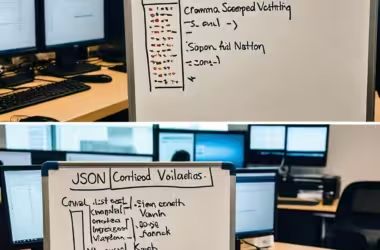In the world of object-oriented programming, following software design rules is key. It helps make software that’s both easy to maintain and can grow with needs. The SOLID principles were put forth by Robert C. Martin (known as Uncle Bob) in the early 2000s. They are like a roadmap that developers can follow. This way, they can make sure their projects stay successful over time.
Adopting the SOLID principles means sticking to certain best practices. These practices help us design and write software that’s clear and easy to build on. Developers who use these principles can be more certain of their projects. They can make software projects that are not just big, but also maintainable.
Key Takeaways
- The SOLID principles are a set of guidelines for writing maintainable and scalable code in object-oriented programming.
- Following these principles leads to software that is easier to understand, extend, and maintain over time.
- The SOLID acronym stands for five core principles: Single Responsibility, Open/Closed, Liskov Substitution, Interface Segregation, and Dependency Inversion.
- Adhering to SOLID principles promotes modular, loosely coupled, and extensible code.
- Embracing SOLID principles is crucial for the long-term success of software projects and ensuring code quality.
Introduction to SOLID Principles
As software systems get more complex, sticking to the SOLID principles becomes super important. It’s all about making sure your code is easy to keep up and can change over time easily. These principles are like the building blocks for writing code that is organized, not too connected, and easy to add onto. This way, developers can make apps that roll with the punches as needs shift.
What are SOLID Principles?
The SOLID acronym stands for five core principles. They help developers write code that’s easy to maintain and grow:
- Single Responsibility Principle (SRP)
- Open/Closed Principle (OCP)
- Liskov Substitution Principle (LSP)
- Interface Segregation Principle (ISP)
- Dependency Inversion Principle (DIP)
Importance of Writing Maintainable Code
In today’s fast-moving tech world, being able to write maintainable code is key. As projects get bigger and needs change, you have to tweak, grow, or refine what’s already there. By sticking to the SOLID principles, developers set up a strong base. This base helps the software stay in good shape as it’s worked on, making changes smoother and lowering the chance of messing things up.
Code that’s easy to keep up makes future work a lot simpler. It’s not just about easier coding; it also makes teamwork better than ever. When everyone follows the SOLID principles, it’s a lot easier to get what each other is doing, change stuff, and work together smoothly. This boosts the entire process of building software.
Single Responsibility Principle (SRP)
The Single Responsibility Principle (SRP) is key in the SOLID principles. It focuses on having cohesive classes. That means each class should do one job very well. This makes classes easier to manage and decreases the chance of unexpected problems.
Definition of SRP
The core idea of SRP is simple: a class should do one thing. It should be focused on a single responsibility. This leads to creating clear, specialized classes. Each class handles just one aspect of the software.
Benefits of Adhering to SRP
Following the Single Responsibility Principle offers many pluses:
- Makes the code easier to break down and understand.
- Boosts the ease of testing since each piece is small and clear.
- Helps in reusing code in different parts of the project.
- Lessens the ties between classes for a more flexible system.
Examples of SRP Violations
One common problem with SRP is when a class does too much. For instance, managing data and also business rules. This makes classes hard to work with and leads to bugs when you make changes.
Refactoring Code to Follow SRP
To fix this, you can break the class’s tasks into separate classes. For instance, you could make one class just for data handling and another for the business rules.
- First, find the different tasks the class is doing.
- Then, create new classes, each focusing on one task.
- Next, move the related code and data to these new classes.
- Finally, adjust your code to use these single-task classes.
By applying SRP, you make your code easier to work with. This approach also leads to better quality software.
Open/Closed Principle (OCP)
The Open/Closed Principle (OCP) focuses on making software systems extensible. It means that once you build something, you should be able to add more without changing what’s already there. This way, the code remains stable, and new features can be added easily.
Understanding the OCP
The OCP says you should be able to add new features to a piece of software without changing its code. This is done by using polymorphism, inheritance, and interfaces. Following the OCP makes systems easier to manage and less likely to break when you update or add features.
Advantages of Applying the OCP
When you use the Open/Closed Principle, you get many advantages such as:
- It makes software more extensible, letting it fit new needs easily.
- There’s less chance of causing bugs by working on the code.
- The code is more organized and easier to understand.
- You can reuse parts of the software without changing how they work at their core.
- It encourages the use of polymorphism and other helpful programming techniques.
So, sticking to the OCP helps developers build software that’s easy to change and keep working well. This lowers the effort and cost of future updates and fixes.
Liskov Substitution Principle (LSP)
The Liskov Substitution Principle (LSP) is key in object-oriented programming. It ensures that behavioral contracts stay true all through inheritance hierarchies. Simply put, if a new object can stand in for an old one without causing issues, you’ve followed the LSP.
Explanation of the LSP
The LSP is all about subtype substitutability. Let’s say you have a base class (Parent) and a derived class (Child). If a Child can smoothly take the place of a Parent, without the program acting up, you’re in line with the LSP. This keeps everything running smoothly and makes your code dependable.
Examples of LSP Violations
Breaking the LSP can mess up your program. It can make your code hard to follow and fix. For instance, imagine a base class Rectangle that sets a positive width with setWidth().
Now, a Square class comes in and changes setWidth(), messing with the height too. This change might cause your objects to go out of whack. In this scenario, a Square can’t step in for a Rectangle because it changes how setWidth() is supposed to work.
Resolving LSP Violations
To fix LSP issues, developers can do a few things:
- First, adjust the code so that the new classes still meet the old expectations.
- Next, think about using new structures or interfaces to keep things clear and avoid too much complexity.
- Also, it might be good to pick composition over inheritance in some cases. Composition can be more flexible and dodge LSP troubles.
Sticking to the Liskov Substitution Principle helps in making better software. Your objects work the way they should all across your program structure. This consistency makes your code more robust and easier to work with.
Interface Segregation Principle (ISP)
The Interface Segregation Principle is key in software design. It focuses on making client-specific interfaces. This means clients shouldn’t need to use interfaces they don’t. It encourages making smaller, tailored interfaces for every client class.
Definition of the ISP
The ISP explains that big interfaces should become smaller and clearer. Each client class should only use the methods it needs. This way, we keep our code modular and easy to manage by segregating interfaces.
Benefits of Following the ISP
There are many pluses to following the Interface Segregation Principle:
- Creating focused, reusable interfaces boosts code reusability.
- It improves how code is organized and read, cutting out unnecessary dependencies.
- Handling changes gets simpler because only specific classes need updating.
- Smaller interfaces are easier to test, improving your code quality.
Examples of ISP Violations
One common mistake is putting too many methods in a single interface. This forces clients to know about methods they aren’t using. For example, imagine an MultiMedia interface for audio, video, and images. If a class only needs to play audio, it still has to deal with video and image features, breaking the ISP rule.
Refactoring Code to Adhere to the ISP
When dealing with ISP violations, developers can fix their code. They do this by creating more focused interfaces. For the MultiMedia issue, you might split it into audio, video, and image interfaces. Now, classes can just use what they need.
- Spot and highlight any big interfaces in the code.
- Split the methods into smaller, logical client-specific interfaces by their roles.
- Change the client classes to just use the interfaces they need, cutting out extra stuff.
- Keep checking and updating the codebase to stick to interface segregation, even with new tasks.
Dependency Inversion Principle (DIP)
The Dependency Inversion Principle (DIP) shapes software design. It encourages loose coupling and abstractions between parts. This means top-level parts shouldn’t rely directly on lower-level parts. Instead, they should both use abstractions to interact. Abstractions should be independent from details.
Understanding the DIP
The DIP suggests using interfaces or abstract classes for component contracts. By using these abstractions, high-level parts don’t need to know about low-level details. This keeps things flexible, helps with reusing code, and makes it easy to change dependencies.
Advantages of Applying the DIP
Easing with the DIP brings several key upsides:
- It makes components more loosely coupled. So, changes in one part don’t shake up everywhere else.
- It improves maintainability by letting us change dependencies easily without touching higher-level code.
- Testing becomes simpler, as dependencies can be swapped with fake data for easier unit tests.
- It boosts code reusability because you design components to use abstract versions instead of specifics.
Examples of DIP Violations
Violating the DIP means high-levels directly use low-level or concrete stuff. For instance, if a class gets and uses a detailed service, it gets stuck with that one. That binds it too hard to shift or grow the service.
Resolving DIP Violations
To fix DIP issues, you add an abstraction layer, like an interface, that shields high-level parts from low-level specifics. High levels use this abstract, while low levels fill in the real deal. Dependency injection helps by providing the actual thing to the high level at the right time.
SOLID Principles in Practice
The SOLID principles can feel hard to grasp at first. However, they are very useful in software development. They help make everything from simple websites to big banking apps better and easier to work with.
Real-world Examples of SOLID Principles
Think of an online store using the Single Responsibility Principle (SRP). Each part of the store does one main thing, like just handling orders or keeping track of what’s in stock. This setup means the store’s code is clear and doesn’t become a confusing mess when changes are made.
If a bank app uses the Open/Closed Principle (OCP), adding new ways to pay or exchange money becomes simpler. This principle allows for adding new stuff without breaking what’s already there. It’s like building with LEGOs; you just add more pieces without messing up what you’ve already made.
Best Practices for Implementing SOLID Principles
When working with SOLID, it’s smart to do a few key things:
- Use design patterns like Factory or Observer to make your code easier to extend and change.
- Make sure everyone working on the code follows the same style and rules. This helps keep the code tidy and easy for everyone to understand.
- Don’t stop at just writing the code well. Keep improving it over time to stick to SOLID principles as your project grows.
Getting better at SOLID is all about learning from experience. It’s important to keep practicing. Working with your team to use these principles well is key. This teamwork makes your code not only good but great.
Challenges in Applying SOLID Principles
The SOLID principles help make software better and easier to expand. But, putting these principles into action can be tough. Developers often face common problems. They must balance SOLID rules with other design needs.
Common Pitfalls and How to Avoid Them
Over-complicating things is a big trap. Aim for simplicity to steer clear. Only use SOLID rules if they clearly improve the code. Also, overlook the impact on speed and you might run into trouble. Use tools to make sure performance stays strong.
Balancing SOLID Principles with Other Design Considerations
Keeping code easy to maintain is important, but not everything. Sometimes, you may need to step away from SOLID to meet other goals, like speed or keeping data safe. This is especially true when working with older code. Finding the right balance with your team is key.
With old code, making it fully SOLID might not be the best choice. In these cases, focus on small but steady upgrades. Think about the costs of changing the code against the benefits.
Teamwork is vital in dealing with SOLID in projects. Regular checks on code, sharing what you know, and sticking to common rules helps a lot. By working together, teams can make better decisions when facing tough choices.
SOLID Principles and Object-Oriented Programming
The SOLID principles are at the core of object-oriented design and programming (OOP). They act as a guide for developers. This helps them make the most of OOP ideas. They lead to better software that’s easier to keep up.
Relationship Between SOLID Principles and OOP
SOLID and OOP work hand in hand. OOP lets you build software that you can use over and over. SOLID rules help arrange the code for the best use of OOP’s power.
They focus on things like keeping parts separate, sharing work between them, and using different shapes of work together. Take the Single Responsibility Principle. It says each part of your code should do just one clear job. This fits with keeping things separate in OOP.
How SOLID Principles Enhance OOP Design
Sticking to SOLID makes OOP design better in many ways:
- The Open/Closed Principle says you should add new abilities to your program without changing existing code. This helps reuse code without messing it up.
- The Liskov Substitution Principle makes sure new pieces of code can fit in right where the old ones were. It keeps everything running smoothly.
- The Interface Segregation Principle helps by making sure different parts of your program only talk to what they need. This keeps things neat and easy to understand.
- The Dependency Inversion Principle means parts of your program can change without breaking the whole thing. It keeps the whole software from falling apart if one part changes.
Following SOLID, developers make systems that are neat, grow easily, and are simple to look after. This improves the quality of your code and software.
Testing and SOLID Principles
Testing is key in software development. It ensures a high-quality and reliable codebase. When we follow the SOLID principles, focusing on modularity, loose coupling, and testability is important.
Importance of Testing in SOLID Code
SOLID code is all about being modular. Each part has its own job. This makes unit testing key. It checks if each class or method sticks to its task. This way, we rule out bugs early and ensure the code works as it should.
Testing Strategies for SOLID Code
Integration testing is also crucial for SOLID code. It ensures that all parts work well together. Thanks to the Dependency Inversion Principle, we can test interactions. This catches any problems early, ensuring a smooth performance.
Test-driven development (TDD) fits perfectly with SOLID principles. It involves writing tests first, then the code. This approach promotes a design that’s easy to test from day one. Following TDD, developers keep the code aligned with SOLID rules, and make it more robust with thorough tests.
SOLID Principles in Different Programming Languages
The SOLID principles help in writing better code, no matter the language. Each language has its own way of following these principles. We will show you how to do this in Java solid, C# solid, and Python solid programming languages.
Applying SOLID Principles in Java
Java is great for using the SOLID principles. It allows for neat code with its object-oriented support. You can use interfaces and abstract classes to keep to the Open/Closed Principle (OCP) and Liskov Substitution Principle (LSP). Plus, Java lets you mark responsibilities well with annotations, ensuring the Single Responsibility Principle (SRP) and Interface Segregation Principle (ISP) are followed.
Implementing SOLID Principles in C#
C# looks a lot like Java and uses many of the same ideas for SOLID principles. It too uses interfaces and abstract classes well. Yet, it has its own cool features, like lambda expressions and LINQ, that make following SOLID principles easier sometimes.
SOLID Principles in Python
Python is a bit different because it’s a dynamic language. This means it uses a unique set of tools for SOLID principles. Instead of interfaces, it leans on abstract base classes, composition, and duck typing. These help with code reuse, keeping things open for change (OCP), and inverting dependencies, following the DIP.
Each language’s way of using SOLID principles is special. But, knowing the particulars of your chosen language is key. It helps you write code that is easy to keep up, expand, and test.
Conclusion
Software development best practices always change. But, the SOLID principles are a constant guide for good code quality. They help in making software that is easy to maintain, grow, and change. These five principles include Single Responsibility and Dependency Inversion.
Learning and applying the SOLID principles at first might take some time. But the benefits in the long run are clear. Software becomes simpler and faster to update. This leads to more efficient work, less issues later on, and better products.
The software field keeps moving forward, but the SOLID principles stay true. They are a key for both experts and newcomers in writing quality software. Mastering them ensures you’re ready for any changes and that your software will last.






